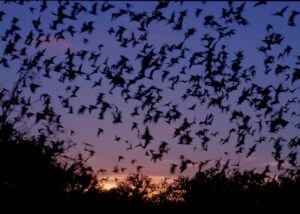“Nature stretches out her arms to embrace man, only let his thoughts be of equal greatness”.
~Ralph Waldo Emerson in “Nature”
For every good thing that we come up with, there can be an opposing downside for nature or wildlife. As we search for ways to produce “greener” energy, researchers are combating some serious – although greatly fixable – problems.
One problemthat is being researched in the last many years is the devastating effects of Wind Farms on migratory birds and bats. Many more bats than birds are actually killed at Wind Farms, although the turbines have caused many deaths to eagles, cranes and others. Regulations limiting the amount of birds that can be killed have been passed, but with bats, it is very hard to put a number on the death rate. Bat carcasses are small and they blend in with the fields and landscape. Some estimates have put the figure around 600,000-800,000+ a year, but no one really knows for sure. And no one knows what % of overall bat populations that that figure equates to.
What is known is that most of these deaths, 80%, occur during migratory months; mid-July to mid-October. This is the time when many species migrate long distances in a group. The hoary bat, which is normally a solitary fellow, travels in huge groups at this time. Bats are attracted to turbines for unknown reasons. Could it be their height -like tall trees – or the noise the turbines make, bugs trapped in the wind currents, or is it something else?
Bats are not killed just by the spinning – which can turn at speeds of 160 miles an hour – acting much like a huge blender in the sky. Although these blades take out large numbers of bats, more than 50% of the deaths occur from “barotrauma”, the air pressure changes due to the sweep of the blades. The bats are unable to detect the invisible low pressure. This causes their internal air passages to rapidly expand, causing internal bleeding, or their lungs to explode. Many bats lying dead on the ground may look unharmed – they have had no blade contact. Also a hazard to the bats is the electrical infrastructure that surrounds some turbines, power lines being an additional hazard.
So what is being done? Wind and migration patterns are being study to determine wind farm placement. Wind Farm operations could be scaled back during migration months. Also, the tilt of the turbine axis can be of help in reducing death. Researchers are working on high frequency noise generators, ultraviolet light, and very importantly, when turbines are “turned on”, and when they are put to idling – known as “feathering” the turbines. When wind speeds are low, bats are most active. Therefore if turbines are put into a feathering 
Renewable energy sources are a wonderful thing and with a few adjustments can be even more so. But in our eyes, not many things are quite as wonderful as our pest controlling “King of the night skies”.


